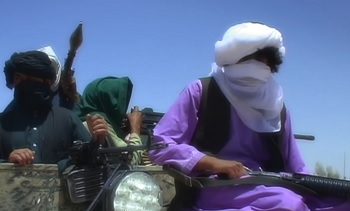Taliban Grows Stronger in Afghanistan Amid Hyper-Focus on ISIS
Michael Hughes
April 16, 2017
ISIS is the primary enemy of external actors while, inside Afghanistan, the Taliban have a higher probability of capturing Kabul and beheading any government officials insane enough not to have fled. Hence, dropping a 21,600 pound bomb on ISIS caves in Nangarhar – as was down by the U.S. on April 13 – does seem like a relatively disproportionate application of resources with respect to the nature of the threat. In fact, the Taliban could benefit from a hyper-focus on ISIS, whose aspirations differ only in terms of geography. Whereas ISIS wants to establish a brutal Islamic State across the entire region, the Taliban want to re-establish the same inside Afghanistan.
From a strategic standpoint, it was somewhat baffling that the Afghan government gave the green light for the U.S. to deploy a Massive Ordnance Air Blast (MOAB) bomb, the largest non-nuclear weapon in Washington’s arsenal, which killed more than 90 militants, considering the group has only about 1,000 fighters on the ground in Afghanistan.
This has allowed President Donald Trump’s critics to claim that he had ulterior motives for deploying the costly “Mother Of All Bombs” in what amounts to a tactical strike, including trying to distract from pressing probes that threaten to undermine the legitimacy of his election, or simply trying to send a message to North Korea.
Former Afghan President Hamid Karzai, for his part, even charged the United States with using Afghanistan as a testing ground for the Pentagon, while insinuating that Afghan government officials may have committed treason by allowing the strike.
To be fair, however, it is important to note that the MOAB’s use was authorized during the Obama administration and at $170,000 per unit, it is not as costly as one would imagine. It also bears mentioning that, as far as we know, no civilians were killed.
Meanwhile, however, the 25,000-strong Taliban control more territory than at any time since 2001 and are responsible for more than 60 percent of the 11,418 civilian casualties suffered in 2016, according to the UN Assistance Mission in Afghanistan (UNAMA). And the Taliban’s campaign of terror shows no signs of letting up.
On April 15, for example, local officials said eleven civilians, including children, were killed by a roadside bomb in the Nawa district of southern Helmand province – a roadside bomb, it is important to note, that was planted by the Taliban.
Infighting between these two terrorist movements is not necessarily something to lament, but the Taliban have been boosted by the focus on ISIS, as RAND Corporation expert Seth Jones said in an analysis in November.
“The Afghan Taliban has benefited from the Islamic State’s decline. The Taliban has strengthened its power, bolstered its reputation, and complicated U.S. and Afghan government efforts to wind down the Afghan war,” Jones stated.
What is deplorable is that some foreign powers are thinking of arming the Taliban because they see ISIS as a bigger threat – the old “the enemy of my enemy is my friend,” strategy. Russia and Iran, among other states, fear that ISIS will use Afghanistan as a base to plan and launch terrorist attacks. In contrast, foreign countries do not see the Taliban as a threat and do not care about the interests of the Afghan people.
Then there is the question of the MOAB’s effectiveness. If dropping bombs was the answer, the wars in Afghanistan, Iraq and Syria would have been wrapped up a long time ago. Killing ten percent of ISIS Khorasan inside Afghanistan is certainly substantial, but the other ramifications are still unknown.
The effect on the local population, for one, is still hard to decipher, but some reports indicate that people were terrified, even those living more than a mile from the explosion – who felt the earth rumble, heard the noise, or tasted the dust in the air.
Ironically, the Taliban even came out and condemned the U.S. MOAB stunt, as if they are suddenly human rights activists. The larger point is, this type of incident could help the Taliban garner more local support.
“Preventing Daesh from making strongholds in Afghanistan is the job of Afghans. They (foreigners) kill people under the name of Daesh and test their weapons,” the Taliban said in a statement after the blast, taking a page out of Karzai’s book in questioning Washington’s motives.
Another long-term ramification is that Karzai, the unlikely voice of sanity, is using the bombing to rally public opinion around forcing the United States out of Afghanistan. During his tenure as Afghanistan’s head of state, Karzai had a well-documented long-running debate with U.S. officials over civilian deaths that Washington saw as “collateral damage.”
“This bomb wasn’t only a violation of our sovereignty and a disrespect to our soil and environment, but will have bad effects for years,” Karzai said in a speech on April 15. “I decided to get America off my soil.”
Of course if Karzai is able to pull of that feat, getting the United States to leave Afghanistan, perhaps something positive will come out of the MOAB bombing, outside of striking a tactical blow against a relatively marginal terrorist group.

